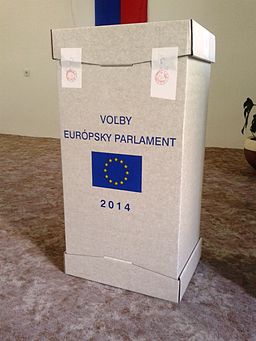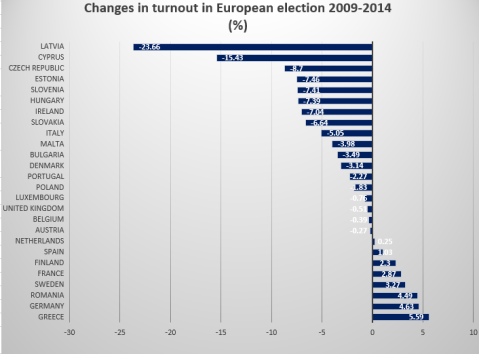Eastern Europe’s euro-elections: from anger to apathy?
The results of the elections to the European Parliament which took place across the EU’s 28 member states last week very much as predicted – at least in the ‘old’ pre-2004 member states: driven by frustration with austerity, economic stagnation, diminished opportunities and a yawning sense of disconnect with established parties and politicians, a variety of outsider parties made sweeping gains and unignorably stamped themselves on the electoral map.
In Northern Europe, where socio-economic malaise and disconnect were often refracted through the politics of anti-immigration, this tended to benefit right wing, Eurosceptic parties. In Southern Europe anti-austerity parties of the radical left such as Greece’s Syriza or Podemos in Spain gained most.
The most spectacular gains were been made by parties of varying political complexions which had a long-time presence on at the political margins: UKIP in the UK, the Front National in France, Sinn Féin in Ireland. Whatever their coloration, scale of their political success underlines the potential fragility of mainstream parties in Western Europe even in states with well-established party systems previously considered immune to populist surges such as Spain or the UK.
Many commentators have lumped in the newer EU member states of Central and Eastern with the unfolding (if exaggerated) story of a populist backlash in the EU’s West European heartlands. Anticipating the strong showing of the radical right in Denmark, Holland and Austria The Observer’s Julian Coman, for example, causally assured readers that ‘across much of eastern Europe, it is a similar story’
But, in fact, it was not.
Outsider parties fall back
Outsider and anti-establishment parties, perhaps surprisingly, did not perform well in Central and Eastern Europe. The extreme right, with the marked exception of Hungary, has long been weak in the region and flopped badly even in countries like Slovenia, Slovakia, Croatia where polls had suggested it might pick up some MEPs.
Hungary’s powerful extreme right-wing party Jobbik widely reported second place (and 14.8% vote share). But this success was more an optical illusion caused by the disunity of the mainstream Hungarian liberal left. The radical right party’s vote share in fact fell sharply compared to the parliamentary elections in April.
The only appreciable success in Central Eastern Europe enjoyed by a new party of the radical right was chalked up by the Congress of the New Right (KNP) in Poland, a political vehicle for the long-time enfant terrible of Polish politics Janusz Korwin Mikke whose eccentric libertarian views variously embrace the restoration of the monarchy; doubts over Hitler’s responsibility for the Holocaust; and suggestions that the European Parliament building be redeveloped as a brothel. The KNP’s modest 7.2% vote gives it four MEPs, including the redoubtable Korwin Mikke.
New anti-political parties of a more centrist persuasion which have been so much a feature of politics in Central and Eastern Europe in recent years also failed to make much of an impact: the ANO movement of billionaire Andrej Babiš narrowly topped the poll in the Czech Republic, but had weaker (16%) support than some polls had predicted. In Slovenia, the hastily formed ‘I Believe’ list created by the former head of the country’s Court of Auditors Igor Šoltés – whose entire campaign reportedly amounted to an intermittently functioning Twitter account – gained a more creditable 10.5%, while in Bulgaria the more controversial anti-corruption party Bulgaria Without Censorship polled 10.7%. But on the Richter scale of ‘earthquake elections’ in the region, these barely register.
A story of turnout failure
The real story of Central and Eastern Europe was, however, one of non-voters: ten of the twelve lowest turnouts across the EU in generally low turnout elections were recorded in post-communist member states. The Czech Republic and Slovakia recording the lowest levels of participation on 19.5% and 13% turnouts respectively – levels of abstention which arguably begin to drain those elected of legitimacy. (Only in Lithuania – where the EU poll coincided with second round of voting in presidential elections – did turnout match the 43% average for the EU as whole.)
Examining changes in turnout reveals a regionally more mixed picture: the biggest falls since are, on the whole, in Central and East European member states such with already low turnout rates. However, some crisis-hit old member states such as Ireland, Cyprus and Italy also experience large drop off, albeit from a substantially higher turnout rates, while both Lithuania and, interestingly, Romania appears as outliers, having seen election turnout rise. The overall picture, however, in CEE is one of draining participation, add odds with the stability over EU-wide turnout between 2009 and 2014 which leaders of EP groups were quick to gloss in optimistic terns as crisis averted.
European elections have, of course, always been a story of turnout failure. Since their inception in 1979, turnout in has been low (and declining) and since Eastern enlargement turnout has always generally been lower still in Central and Eastern Europe, where European integration has always been a technocratic, top-down project with limited societal engagement. Voters in the region may sense that small, poorer post-communist states have a limited real influence on the direction of EU affairs, but few realistic exit options.
It is also perhaps is worth reflecting that Central and East Europeans have already turned to new anti-establishment protest parties in large numbers in recent national elections: they have not needed the opportunity of the European elections to cast mass protest votes triggering electoral earthquake of the kind UKIP celebrated last week. Having now used up this option, many voters in the region have moved on to the next stage and simply switched off and disengaged from the electoral process altogether.
Given this prior history, it is tempting to wonder that in some ways Central and Eastern European voters may be ahead of the game. If the various victorious protest parties of 2014 disappoint, in 2019 will we see the spread of near-critical rates of abstention seen in Slovakia or the Czech Republic. Non-voting, rather than populist protest voting could prove the real long-term threat to sustainability of the EU’s troubled democratic institutions.



You must be logged in to post a comment.